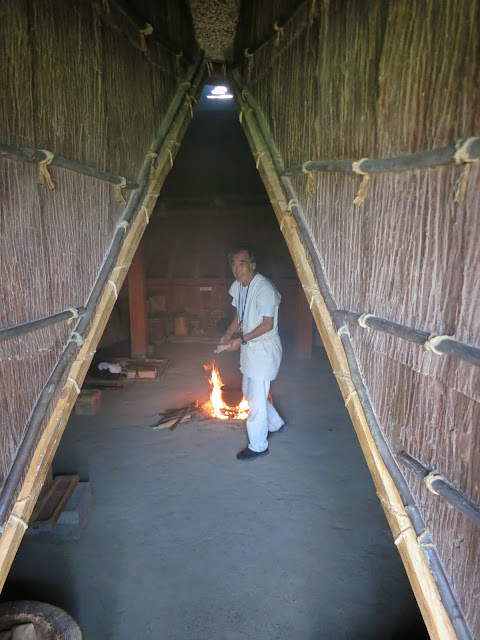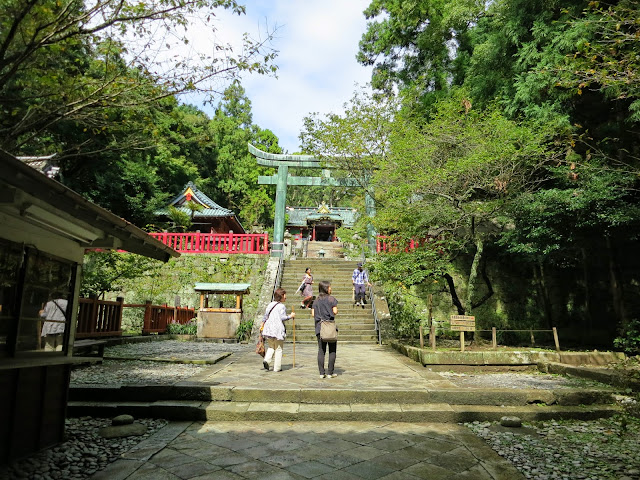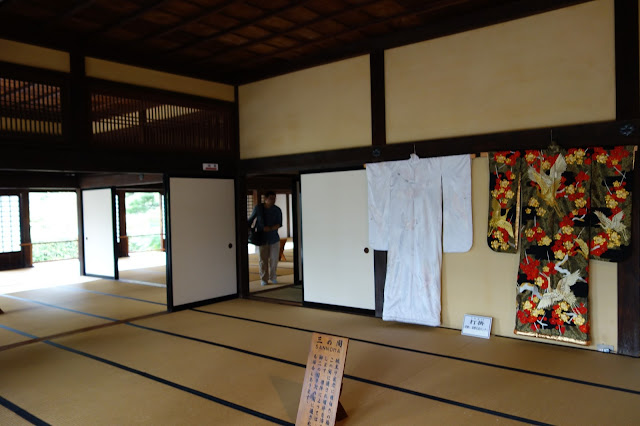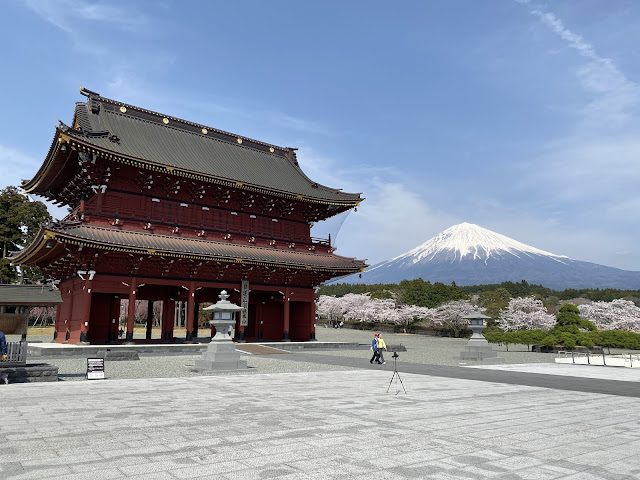Shizuoka(静岡)is a pretty big prefecture located in Chubu(中部), where part of Mount Fuji(富士山)and the Izu Peninsula(伊豆半島)lies in. It is known for green tea(緑茶), and locals there are known to be nice(優しい), which we witnessed!
During my first trip there which was in September 2012, spent about 4D3N checking out the prefecture from west to east. We first reached Kakegawa(掛川)via Shinkansen(新幹線), took Steam Locomotive from Shimada(島田)to Kawanehon(川根本), spent 1D1N in Shizuoka City(静岡市), another 1D1N in Gotemba(御殿場), then headed down to Shimoda(下田)in Izu Peninsula also for 1D1N. Areas like Hamamatsu(浜松), Fujinomiya(富士宮)and Atami(熱海)that we skipped have things to offer too, so checking out the whole prefecture would probably take a week!
Riding on Oigawa(大井川)Main Line's Steam Locomotive from Kanaya(金谷)station to Senzu(千頭)station was interesting. Literally "choo choo train chugging down the track" + harmonica music + green tea plantation scenery outside the opened windows + locals waving to us when the train passed by + delicious local bento, enjoyed the travel back in time experience! A round trip cost around 4000 yen and making reservations in advance is required.
At the final stop-- Senzu station, we checked out Otogi no Sato(音戯の郷), a simple sound museum near the station and had tea at a green tea shop while waiting for bus to Sumatakyo Onsen(寸又峡温泉).
Instead of the hot spring, what we wanted to visit was Yume no Tsuribashi(夢の吊橋), a suspension bridge across a beautiful lake. It is a 1.4 km walk from the bus stop we alighted. The eatery we passed by actually served raw deer meat, though we didn't try. Had Warabi mochi which was delicious!
We took bus back to Senzu station, followed by normal train to Kanaya station and another to Shizuoka station. Stayed at Victoria Hotel, a decent business hotel near the station.
The next day, visited Sumpu Castle(駿府城)nearby, the ruins of Tokugawa Ieyasu(徳川家康)former castle/retirement home. His rule in Japan marked the beginning of the Edo period. Sumpu is the old name for Shizuoka city.
We also visited Toro Iseki(登呂遺跡), the first archaeological site excavated in Japan in which remains of a 1st century AD Yayoi period wet-rice paddy fields were found.
Next, we took a bus to Nihondaira(日本平)from Shizuoka station, then took a ropeway up to Kunozan Toshogu(久能山東照宮), Ieyasu's second most important mausoleum, after the one in Nikko(日光). There is also a museum which exhibits Ieyasu's personal belongings and the shrine's treasures, including Ieyasu's cautionary manual to Gou~
From Shizuoka, we took a 2 hour train to Gotemba(御殿場). Stayed in Alpha 1 business hotel some distance away from the station. The location wasn't that convenient, though it has an onsen facility with views of Mount Fuji! Too bad it is difficult to see the whole Mount Fuji in summer.
We went shopping at Gotemba Premium Outlet the next day, and had relaxing onsen at Hakone's(箱根) Yunessun (more info under Hakone). At the end of the day, we took train to Shimoda(下田)at the southern end of Izu Peninsula where we stayed for the night. Service was good and I like the vibe of the ryokan(旅館)-- Rendaijiso(蓮台寺荘). We booked a stay without meals as our timing was bad.
The next day, we roamed around the Izukyu-Shimoda(伊豆急下田)station area. Shimoda is the landing place of Commodore Perry's black ships in 1854, which signifies the end of Japan's isolation and start of US and Japan's diplomatic relations. The town is tranquil, dotted with many temples, shrines and historical buildings. There is Hofukuji(宝福寺), a Sakamoto Ryoma-related site (where Katsu Kaishu met with Yamauchi Yodo to ask forgiveness for Ryoma Sakamoto's banishment from the clan).
We kept walking and reached a beach, but not the Iritahama Beach(入田浜)that we wanted to go. Rested at a cafe, asked the cafe owner for directions, and a kind customer who overheard us actually volunteered to give us a ride in her car!
Iritahama was voted as the most beautiful beach in Japan for several years, though I couldn't quite tell because it was raining......
Lunch was Sashimi set at restaurant Gorosaya which is walking distance from the station. Seafood is must-eat in Izu Peninsula.
We took train to Kawazu Station(河津)and transferred to bus for Kawazu Nanadaru(河津七滝)-- seven waterfalls along a walking trail. We didn't have much time, saw four in about half an hour.
Kawazu is also famous for viewing kawazu sakura(河津桜), a type of cherry blossom that blooms early, usually in late February.
My second trip to the prefecture was a day-trip from Tokyo to Shizuoka city for Ikimono Gakari's concert. My third trip was to Atami(熱海)for a fireworks festival. This town has fireworks festivals on quite a few weekends! Though accommodation has to be secured early. I tried making a reservation 1 month in advance, but wasn't able to secure one with onsen facility. Went for a daytime onsen package instead, at KKR Hotel which has an outdoor bath with sea view. It is necessary to check its website for opening days/timings and discounts.
I found the town a little rundown and nothing special compared to other hot spring towns. Though their raw sakura-ebi(桜海老)was great!
During this trip, I also visited Kakegawa Castle(掛川城), which is at the other end of the prefecture. It is a rebuilt castle that requires some climbing. More notable is the palace beside with a longer history.
My fourth trip to the prefecture was during Golden Week in 2018, when I joined a bus tour to the Mount Fuji region. Other than Fuji Shibazakura Festival (more information under Yamanashi prefecture), I also went to Grinpa amusement park for tulips and Izu Fruit Park for 30 minutes unlimited strawberry picking!
My fifth trip to Shizuoka prefecture was in Spring 2025, mainly for cherry blossom viewing. I visited the two places in the prefecture chosen as "Top 100 Cherry Blossom Spots in Japan"-- Fuji Cemetery(富士霊園)and Sakura no Sato(さくらの里).
I also went to Ryuganbuchi(龍巌淵)and Taisekiji temple(大石寺)for Sakura + Mount Fuji view. It is more difficult to see the whole Mount Fuji from the Shizuoka side than Yamanashi side (such as Kawaguchiko), also harder to see in spring compared to winter, so I am really thankful for the great weather conditions the day when I visited.
I also checked out the photo spot-- Mount Fuji Great Dream Bridge(富士山夢の大橋), Mount Fuji World Heritage Center (from the outside only) to appreciate the interesting architecture, and tried the famous Shizuoka-only hamburger steak chain restaurant Sawayaka. Unexpectedly, my favorite was the freshly baked bread!












































































0 comments:
Post a Comment